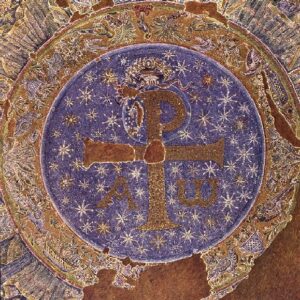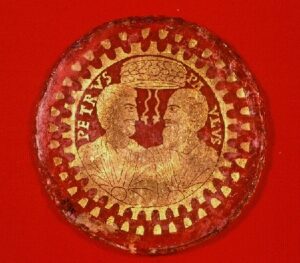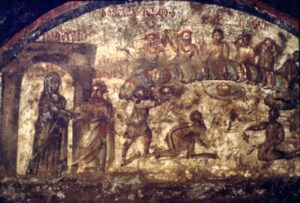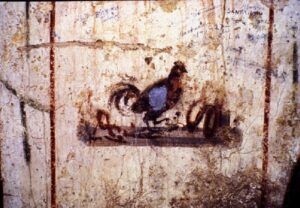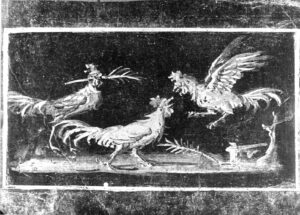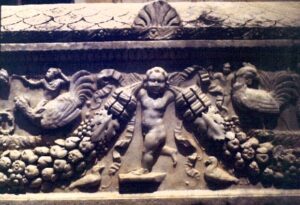Victory and Coronation. Excerpt from: Estelle Shohet Brettman, Vaults of Memory: The Roman Jewish Catacombs and their Context in the Ancient Mediterranean World, with Amy K. Hirschfeld, Florence Wolsky, & Jessica Dello Russo. Boston: International Catacomb Society, 1991-2017 (rev. 2024).
Trees like the palm tree and its branches had been represented in sacred and funerary contexts for many millennia. Thus the faithful and the pure who, like Jesus and all suffering martyrs, had conquered the vicissitudes and temptations of earthly life, would be rewarded with palms, crowns, and wreaths from "the tree of eternal life" in the same manner that victorious contestants in the events of the palestra, stadium and circus were glorified.
Fig. 1. Date Palm. A palm tree, with two date clusters symbolizing the fertility of the earth, decorates the angle of a cubiculum in the catacomb of Vigna Randanini in Rome. The palm was a symbol of victory in the ancient world. In a funerary context, it meant victory over death. Jesus was greeted with palms upon his triumphal entry into Jerusalem and, for the martyrs, the palm signified the triumph of their faith and the assurance of their glory in the face of death. The paradisiacal scene includes a water fountain spouting from a vessel surrounded by roses, which in the Roman world of chariot racing also symbolized victory. Painting on right entrance wall.
Fig. 2. (DAPICS nn. 1306.-1307.) A Crown for the Victorious. Vault painting of Cubiculum I in the Catacomb of Vigna Randanini. Upon this vault, which may represent the "Dome of Heaven", a winged Victory (Greek Nike) crowns a nude youth with a laurel wreath, a prize for the victorious, as was the palm branch in her left hand. This symbolism can be traced back through Roman imperial iconography to earlier Greek motifs. "The Lord shall be a crown upon the head of every righteous man," (Isaiah 28:5 paraphrased in BT, Sanhedrin 111b.).
Fig. 3. Aureus of Vespasian, Mint of Rome. Victory, holding a palm in her left hand, is about to crown Vespasian (69-79), the emperor who reigned during the fall of the Second Temple. The coin actually commemorates a victory of Vespasian's general, Trajan the Elder, in Syria in 77-78. Reverse.
Fig. 4. Mosaic from the Baptistery of St. John, Naples. The hand of God crowns the first two letters of the Greek word for Christ (chi and a nimbed rho) with a jeweled laurel wreath. An alpha and omega flank the Christogram in the starry vault of heaven, all encircled by the birds and flora of Paradise. In the center of the band above the hand of the Lord stands a haloed phoenix, ancient symbol of immortality. Second half of the fourth century CE.
"And when the chief Shepherd appear, ye shall receive a crown of glory that fadeth not away"(I Pet. 5:4).
"Thou shalt also be a crown of glory in the hand of the Lord, and a royal diadem in the hand of thy God" (Isa. 60:3).
Fig. 5. Peter and Paul Crowned. Gold glass in the Vatican Museums: "Be thou faithful, unto death and I will give thee a crown of life" (Rev. 2:10).
Fig. 6. Vibia's Reward. In an episode in the cycle of Vibia's adventures after her departure from this world, a conflated scene pictures the "good angel" holding Vibia's crown of the "righteous." The angel is about to introduce her to the pleasures of the hereafter through the portal of "induction." On the right, banqueters repose in back of the usual semicircular, strapped bolster. On the left, Vibia and two joyous companions, adjudged virtuous, are crowned and attired in dalmatics with clavi. Like the accompanying angel the two celebrants wear garlands. Vibia holds an object aloft, probably a garland. The remaining three participants on the right appear rather dejected or bewildered and perhaps were not favorably judged. Palm branches figure in the background and two youths also clad in dalmatics with clavi pick flowers in a meadow. A third youth proffers a platter with poultry; a basket of bread and a plate with a fish are also visible. An amphora for wine further on the right does not appear in the photograph. Although badly deteriorated, this fresco offers an another excellent example of the impressionistic style of painting in the Roman catacombs in which facial contours and eyes are modeled in shadow. Lunette painting, arcosolium in the Hypogeum or Catacomb of Vibia, Rome.
"The righteous shall flourish like a palm tree" (Ps. 92:12) And in the world to come the "righteous will sit, their heads crowned, delighting in the glory of the Divine Presence."
Fig. 7. Apotheosis of a Soldier. The portrait bust of the deceased is framed in a laurel wreath clipeus and flanked by philosophers holding scrolls in the lunette of an arcosolium. Motifs of victory and ascension; charioteers and angelic Victories with wreaths and palms, eagles on orbs and pegasoi among other familiar themes decorate the attic of the arch and the vault. Lunette painting. Catacomb of the Vigna Massimo, Rome. Drawing from Paolo Aringhi, Roma Subterranea Novissina, 2 vols. Rome 1651: "And a crown was given unto him: and he went forth conquering and to conquer" (Rev. 6:2).
Fig. 8. Cock with Symbols of Victory. In this metaphorical scene the valorous cock is depicted as victorious in waging the battles of life. He stands near the familiar columella bedecked with wreaths and fillets. Painted left wall. Cubiculum in the Catacombs of Vigna Randanini, Rome.
Fig. 9. Fighting Cocks. The victor gloats, surrounded by such appurtenances of his success, such as palm branches, an elegant vessel, and a dead foe. A herm, a stone pillar crowned with a head of Hermes, the divinity who oversees such contests, surveys the scene. Wall painting, left ala (wing) of atrium, House of the Vettii in Pompeii.
Fig. 10. (DAPICS n. 1832.) Above a swag of laurel leaves and a festoon laden with many fruits, a proud cock struts with a wreath of victory in his talons, while his vanquished opponent seems to be crowing in frustration. A palm branch decorates the background of the simi-law scene on the left. Known for their persistence in fighting even to the death, the courageous cocks were attributes of the Greek goddess Athena and were sacrificial offerings in the rituals of the various sects coexisting in the Roman Empire. Marble sarcophagus. Ostia.
Fig. 11. Sporting Games for the Ages. Greek youths train gamecocks for the contest. Attic black figure kylix, 530-520 B. C.E.
Fig. 12. A Fitting Emblem for a Royal Official. The cock ready to do battle is carved in sketchy fashion on the seal of Ya'azanyahu (Jaazaniah), a name meaning "God will hear," which is most appropriate given the crowing abilities of his chosen emblem. The rest of the Hebrew legend incised on the two registers informs that the owner of the seal was an important royal official entitled "servant ('ebed) of the king." Banded agate scaraboid. Late eighth to seventh centuries B. C. E. From Mizpah (Tell en-Nasbeh).



